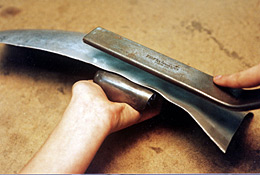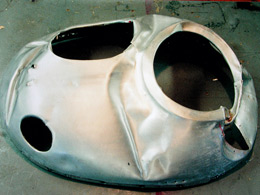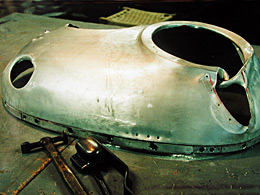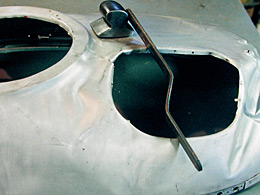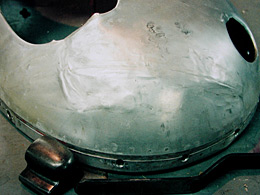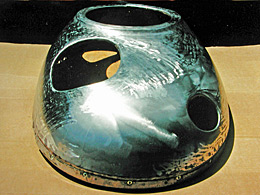How to Smooth Wavy Metal with Spring Steel Slappers
The spring steel slapper is a smooth-faced spring steel hand tool that is great for smoothing wavy metal:
- Support the rumpled metal with the dolly, and while lifting up, whack the top surface with the slapper.
- It helps to bump up the big low spots with the dolly first.
- Then with some practice, you work on smacking the metal right over where you are lifting up with the dolly.
- High spots can be knocked down with the slapper without having any dolly underneath.
- Shrinking can be done by heating the wavy surface in a 2 inch spot and then bumping the high spot down with the slapper.
- Gentle hits will smooth the last small waves gradually, without stretching the metal.
- Some gentle filing was done to check the surface, then some more working, and then a final file-over, with some sanding to soften the roughness of the surface for paint.
Click on images to view larger.
Holding the autobody dolly in one hand and striking with the slapper in the other hand. For accuracy and control of the tool it is helpful to grip it with one finger extended out onto the flat of the tool. You must Lift UP with the dolly for the slapper to level the metal.
This damaged nosebowl is .050” (1.5mm) thick and is 5086 alloy aluminum. You can see bulges where I have already bumped the dent up from behind, using the autobody dolly.
By alternately bumping up the big dents and leveling with the slapper the surface smooths out.
Here is a close-up of the work in progress, with the two tools I am using here.
Another view shows dark spots where the slapper has struck the metal and the dolly together, very solidly, with a clear “tink.” The feel of a solid strike and the “tink” sound indicate stretching of the metal. If the sound of the strike is hollow and without the hard contact then the metal is likely being shrunk. I also used some heat to relax the metal while slapping. This hot working helps the metal shrink and overcomes the combined work-hardness of the wreck and the straightening.
I have check-filed the surface to see the low spots and lifted them with another pass with the slapper and dolly. Then I check-sanded with 320 paper to see how much marking I was leaving and how well the part would clean up for paint. This is a paint-grade part, as original for a painted Ryan STA single-engine airplane.
